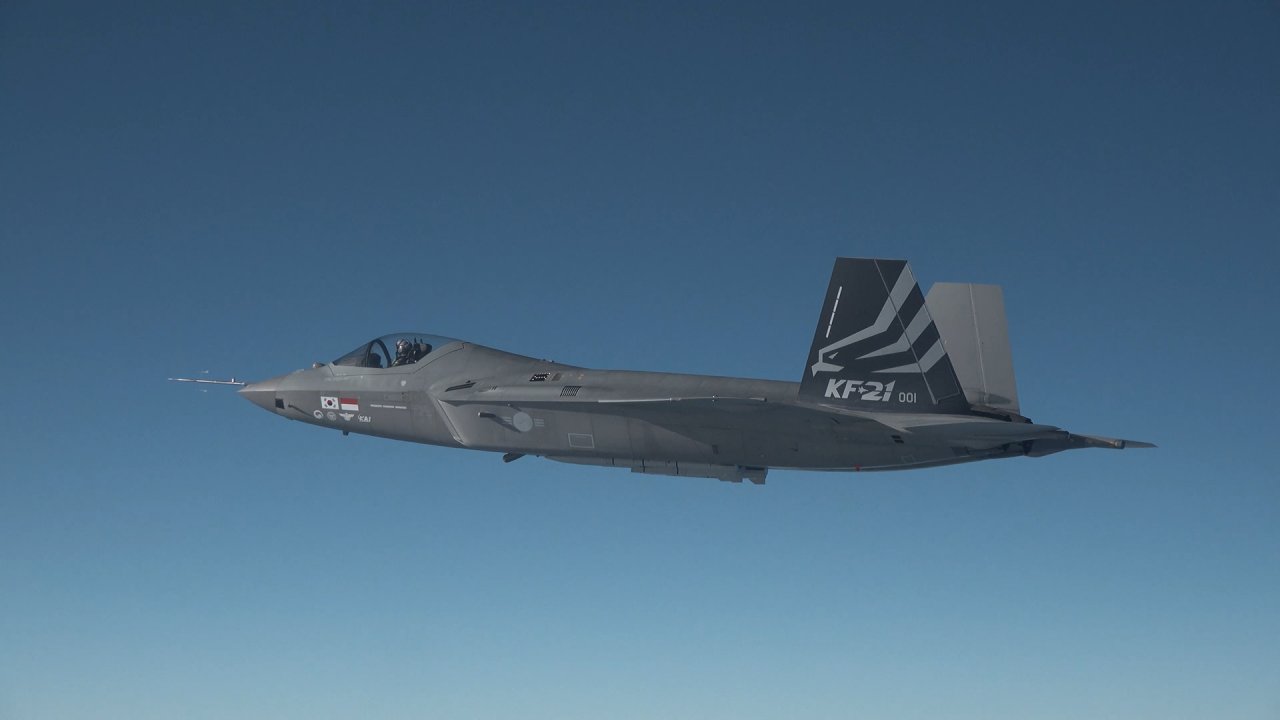
A KF-21 Boramae fighter prototype took off for its first-ever supersonic test flight on Tuesday at 2:58 p.m. at the base of South Korea’s Air Force 3rd Training Wing in the city of Sacheon, South Gyeongsang Province, according to the Defense Acquisition Program Administration.
The prototype No. 1 of the KF-21 fighter jet broke the sound barrier, flew supersonically at an altitude of 12,000 meters from 3:15 p.m and landed at 3:54 p.m.
Supersonic speeds exceed Mach 1, meaning faster than the speed of sound. The speed of sound is about 1,236 kilometers per hour at sea level. A bullet fired from a gun flies at supersonic speeds, for instance.
The success of the KF-21 supersonic test flight — which is essential to ensure a fighter jet’s key functions perform properly regardless of flight speed — has significance in the research and development of the KF-21, South Korea’s state-run arms procurement agency said.
The supersonic flight demonstrated that the KF-21 can “maintain its structural stability at supersonic speeds, given that the KF-21 was able to overcome shock waves.”
“When an aircraft exceeds the speed of Mach, shock waves occur on the aircraft such as its wings due to air drag and other accompanying phenomena,” the DAPA said, underscoring the importance of achieving supersonic capabilities in developing the KF-21. “Unsteady airflow — that exists surrounding the aircraft — would have significant (adverse) impacts on the structural soundness of the aircraft.”
More importantly, the KF-21 marks the first indigenously developed supersonic aircraft that South Korea has successfully flown.
The United States, Russia, China, Japan, France, Sweden and a European consortium — comprising the United Kingdom, Germany, Italy and Spain — are the only others to have developed and flown 4.5- or 5th-generation advanced supersonic fighter jets.
The DAPA explained that the T-50 Golden Eagle light supersonic trainer jet was jointly developed by Korea Aerospace Industries and US-based Lockheed Martin.
The success of the supersonic flight came around six months after South Korea began its journey of test flights in July 2022. South Korea has expanded the flight envelope of the KF-21, including altitude and speed, by conducting around 80 sorties of test flights since then, according to the DAPA.
South Korea will conduct approximately 2,200 test flights with six KF-21 flyable fighter prototypes until 2026. South Korea has so far conducted test flights of KF-21 prototype Nos. 1, 2 and 3.
“The success of the supersonic flight has enabled our military to further solidify the foundation for building a strong military based on advanced science and technology,” South Korea’s Defense Minister Lee Jong-sup said. “The country has also taken a step forward to becoming one of the world’s top four defense exporters.”
South Korea plans to conduct more intensive supersonic test flights by flying the KF-21 at a higher altitude and a faster speed to thoroughly examine and verify flight stability at supersonic speeds. The outcome of the test flights will be reflected in the research and development of the immaculate KF-21 advanced supersonic fighter jet.
The KF-21 program, dubbed KF-X, is the largest-ever defense project that is run by the South Korean government. The development of 4.5-generation KF-21 Boramae aircraft — which has has very low observability compared to a fourth-generation fighter — requires 8.8 trillion won ($7.1 billion), of which Indonesia has committed to contributing 20 percent.
The KF-X consists of two stages over 13 years, from 2015 to 2028. The first stage focuses on developing the aircraft and its maneuverability for air-to-air combat between 2015 and 2026. Aircraft capabilities to carry out air-to-ground operations are to be developed in its second phase, between 2026 and 2028.
Korea Aerospace Industries aims to deliver 120 KF-21 fighter jets to South Korea’s Air Force by 2032.





![[KH Explains] How should Korea adjust its trade defenses against Chinese EVs?](http://res.heraldm.com/phpwas/restmb_idxmake.php?idx=645&simg=/content/image/2024/04/15/20240415050562_0.jpg&u=20240415144419)